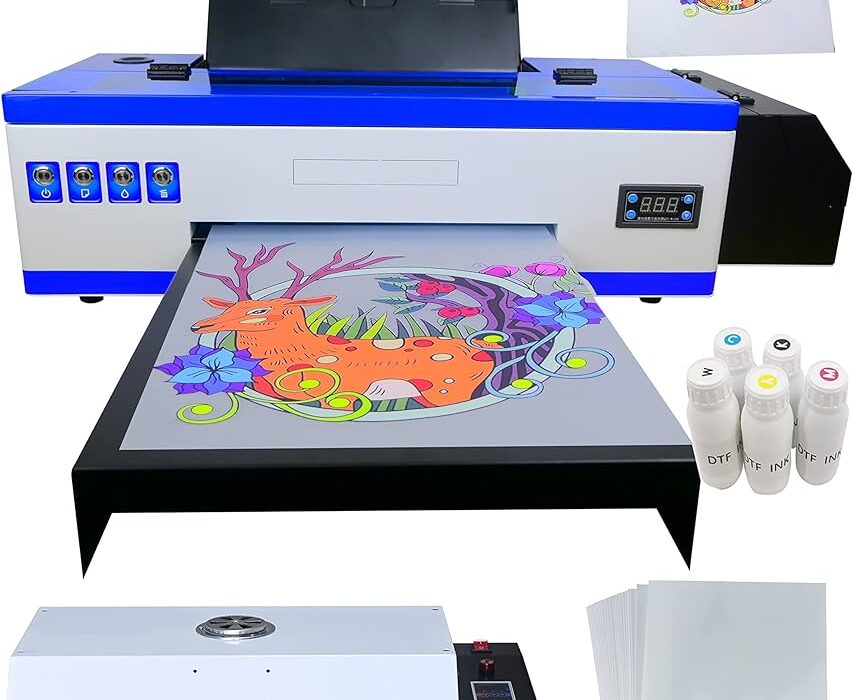Dtf Printer

A DTF Printer, or Direct to Film printer, transfers designs onto film before heat pressing them onto fabrics. This technology provides versatility in textile printing without the need for pretreatment.
DTF printers have revolutionized the textile industry with their ability to print vivid, detailed designs on a variety of fabrics. They employ a simple process where the printer first prints the desired graphic onto a special film. Then, adhesive powder is applied, the print is melted to cure the powder, and the final step involves transferring the design from the film to the textile under heat press.
This method is highly efficient for short-run orders and on-demand printing, making it a favorite for custom apparel businesses and designers looking to create high-quality, durable prints on cotton, polyester, and blends. With less setup time than traditional screen printing and the ability to print full-color graphics, DTF printers offer a flexible solution for modern textile printing demands.
The Rise Of Dtf Printing Technology
Direct to Film (DTF) printing technology is taking the garment industry by storm. A new breed of apparel customization offers vibrant prints on a variety of fabrics. This innovative printing method promises versatility and ease.
What Is Dtf Printing?
DTF printing stands for Direct to Film. It is a process of printing designs onto special films. These are then transferred to clothes using heat and pressure. This method suits multiple fabric types without the need for pre-treatment.
Comparing Dtf To Traditional Methods
- Speed: DTF prints faster than traditional screen printing.
- Color Range: It offers wider color choices than DTG (Direct to Garment).
- Flexibility: It works on cotton, silk, polyester, and blends.
- No Pre-treatment: Fabrics do not need preparation before printing.
Screen printing and DTG have ruled the market. DTF introduces improved efficiency. Many businesses shift to DTF for its cost-effectiveness and excellent outcomes on diverse textiles.

Credit: www.swingdesign.com
Key Components Of A Dtf Printer
Digital Transfer Film (DTF) printers are taking the textile industry by storm. But what makes them tick? To fully understand their potential, a deep dive into the key components is essential. Each part plays a pivotal role in delivering vibrant prints onto a variety of fabrics. Now, let’s unlock the magic behind these innovative machines.
Understanding The Ink System
At the heart of any DTF printer is its sophisticated ink system. This system works seamlessly to ensure that ink flows consistently to the print head. Crucial to this process are a few core elements that you should know about:
- Ink tank: Stores the bulk of the DTF ink.
- Dampers: Regulate the ink flow to the print head.
- Print head: Applies ink onto the film with precision.
- Capping station: Maintains the print head’s moisture.
Ensuring these parts work in harmony is vital for high-quality prints without disruptions. DTF printers typically use CMYK and white inks, and sometimes additional spot colors, all of which must be carefully balanced within the system.
The Role Of The Powder Shaking Unit
Following the application of ink, the DTF process requires a key component: the powder shaking unit. This device not only applies but also cures the adhesive powder that bonds the ink to the fabric. It’s fascinating to observe how it functions so efficiently:
- The unit evenly spreads adhesive powder over the wet ink.
- Excess powder gets removed and collected for reuse.
- A built-in heating element cures the powder onto the ink.
This unit is cleverly designed to create a strong bond between the ink and the final substrate, which is crucial for durable and vibrant transfers. Without this component, DTF prints would lack the resilience and quality that set them apart.
Advantages Of Using Dtf Printers
The digital textile printing industry is evolving with the introduction of Direct to Film (DTF) printers. These printers are becoming popular due to their unique advantages. From small businesses to large scale operations, DTF printers offer solutions that traditional printing methods cannot match. Let us explore some of these benefits.
Versatility Across Materials
DTF printers excel in versatility. Unlike traditional printing techniques, these modern marvels can print on a variety of materials. From cotton and polyester to silk and leather, DTF printers handle it all. This opens up a world of possibilities for product offerings.
- Multiple fabric types: Able to print on a mix of textiles.
- Diverse products: Suitable for T-shirts, hats, and even shoes.
Durability Of The Prints
Long-lasting prints are a cornerstone of DTF printing. The technology ensures that designs withstand washing and wear. This durability is a key selling point for businesses and consumers alike.
| Feature | Benefit |
|---|---|
| Wash resistance | Longer-lasting designs |
| Color fastness | Vibrant colors that do not fade |
Cost-effectiveness For Businesses
DTF printers are a cost-effective solution for businesses. They reduce the need for large inventory stocks and allow for on-demand printing. This minimizes waste and maximizes profits.
- No need for pre-treated fabrics.
- Minimal setup time for small print runs.
- Lower production costs for custom prints.

Credit: www.amazon.com
Setting Up Your Dtf Printing Station
Embracing the world of print-on-demand, the DTF (Direct to Film) printer is making waves. Setting up your DTF printing station correctly is essential for high-quality prints and efficient workflow. This guide will take you through each step, ensuring your print station is up to the task.
Selecting The Right Printer
Choosing the perfect DTF printer is crucial. Consider these points:
- Print Quality: Look for high resolution and color accuracy.
- Speed: Check the print speed for efficient production.
- Size Compatibility: Ensure it handles the media sizes you need.
A comparison table can help in decision making:
| Printer Model | Resolution | Print Speed | Max Media Size |
|---|---|---|---|
| Printer A | 1440 dpi | 10m²/h | A3 |
| Printer B | 720 dpi | 8m²/h | A2 |
Workspace Requirements
Your workspace impacts productivity and safety. Ensure these features:
- Proper Ventilation: Keep the air fresh to remove fumes.
- Stable Environment: Avoid dust and maintain a consistent temperature.
- Organized Layout: Have a place for everything for efficient operation.
Imagine a clean, well-lit table with labeled supplies for your station.
Maintenance Tips
Maintenance ensures longevity and reliability. Remember:
- Daily print head cleaning prevents clogs.
- Regular firmware updates keep the printer running smoothly.
- Periodic inspections of rollers and belts avert wear and tear issues.
Follow the manufacturer’s guidelines for specific care instructions. Stick to a maintenance schedule for peak performance.
Troubleshooting Common Dtf Printing Issues
Direct to Film (DTF) printing is revolutionizing the fabric industry with its ease and efficiency. But as with any new technology, users may encounter challenges. This section delves into common issues and provides solutions to keep your DTF printing smooth.
Ink Flow Problems
Ensuring consistent ink flow is crucial for high-quality DTF prints. Issues can arise, causing frustrating blockages or leaks.
- Check cartridges for proper installation.
- Clean the print head routinely to prevent clogs.
- Use the recommended ink type for your printer.
Following these steps can maintain a steady flow of ink.
Film Adhesion Challenges
A typical challenge is the film not adhering properly.
- Ensure the printing surface is clean.
- Adjust the heat press temperature if needed.
- Test different films to find the best fit for your printer.
Perfecting film adhesion helps avoid peeling and ensures durability.
Quality Control Measures
Quality prints stem from thorough control measures.
| Measure | Action |
|---|---|
| Regular Calibration | Calibrate regularly for color accuracy. |
| Rigorous Testing | Conduct tests on different fabrics. |
| Maintenance Schedule | Adhere to a strict maintenance routine. |
Proactive quality control identifies issues before they affect output.

Credit: store.apcink.com
Future Prospects Of Dtf Printing
The journey of Direct to Film (DTF) printing is just beginning. Exciting doors are opening for design enthusiasts and the fashion industry alike. DTF printing promises vibrant prints on a vast array of fabrics. It’s a journey of color, creativity, and innovation. Let’s dive into what the future holds for this dynamic printing technology.
Innovations On The Horizon
Research and development teams are working tirelessly. They aim to enhance DTF printing machines. They focus on faster print speeds and higher quality results. Technological advancements are on their way to make DTF printing even more versatile and efficient.
- Eco-friendly Inks: Manufacturers are developing more sustainable options. These inks will reduce environmental impact.
- Improved Durability: New treatments aim to extend the life of DTF prints. These treatments will help prints withstand washing and wear better.
- Software Integration: Software innovations will simplify the design-to-print process. These will make DTF printing more accessible for all skill levels.
Potential Market Growth
Market analysts predict a booming future for DTF printing. Its ability to cater to small and large orders positions it well. With the rise of personalized apparel, the demand for DTF printing is set to soar. Here’s a snippet of its potential market growth:
| Year | Market Size | Growth Rate |
|---|---|---|
| 2023 | $XX Million | XX% |
| 2024 | $XX Million | XX% |
| 2025 | $XX Million | XX% |
Businesses can expect to see wider adoption across various industries. Custom fashion, home décor, and advertising will benefit greatly from DTF printing. Entrepreneurs and creators can leverage DTF’s flexibility to expand their offerings.
- New Business Opportunities: DTF printers enable start-ups to enter the market with minimal investment.
- Personalization Trend: Consumers are seeking unique products. DTF printing caters to this desire with custom designs.
- Expanding Fabric Compatibility: Future DTF printers will work with an even broader range of materials.
Frequently Asked Questions Of Dtf Printer
What Kind Of Printer Do I Need For Dtf?
You need a Direct to Film (DTF) printer, capable of handling DTF inks and film transfer sheets, designed specifically for DTF printing processes.
Is Dtf Better Than Sublimation?
DTF printing offers greater fabric versatility and simpler setup than sublimation, which requires polyester materials. Sublimation excels in durability and feel but is less flexible regarding applicable fabrics.
Can I Use A Regular Printer For Dtf?
No, you cannot use a regular printer for Direct to Film (DTF) printing as it requires a specialized printer compatible with DTF inks and processes.
What Are The Disadvantages Of Dtf Printers?
DTF printers can be costly, have high maintenance needs, and require specific inks and transfer films. They may also have a learning curve for proper operation and can experience occasional clogging issues with white ink.
Conclusion
Navigating the realm of digital fabric printing need not be daunting. The DTF printer stands as a beacon of innovation, streamlining textile customization. With its precision, efficiency, and versatility, your creative endeavors find a reliable partner. Embrace the future of printing; let the DTF printer transform your designs into vibrant realities.










